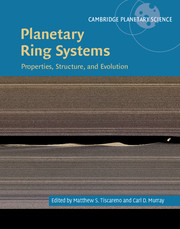1 - Space Age Studies of Planetary Rings
from I - Introductory Material
Published online by Cambridge University Press: 26 February 2018
Summary
INTRODUCTION: THE ALLURE OF THE RINGED PLANETS
One of the most enduring symbols of space exploration is a planet surrounded by a ring. This symbol inspires a celestial context: nothing on Earth is like it. It has been a wonderful surprise that the ringed planets are just as beautiful and scientifically compelling seen close up. Furthermore, the ringed planets are not just objects of beauty, but complicated physical systems that provide a local laboratory and analogy for other cosmic systems like galaxies and planet-forming disks. For a general review, see Esposito (2014). For more details, see the individual chapters that follow in this book.
We now know that planetary rings, once thought unique to the planet Saturn, exist around all the giant planets. These rings are not solid objects, but are composed of countless particles with sizes from specks of dust to small moons. For each planet, the rings are quite different. Jupiter's ring is thin and composed of dust-like small particles. Saturn's rings are broad, bright, and opaque. Uranus has narrow, dark rings among broad lanes of dust that are invisible from Earth. Neptune's rings include incomplete arcs restricted to a small range of their circumference. All rings lie predominantly within their planet's Roche limit, where tidal forces would destroy a self-gravitating fluid body. They are also within the planet's magnetosphere and, in the case of Uranus, they are within the upper reaches of the planetary atmosphere.
The common occurrence of ring material around the outer planets is one of the major scientific findings of the past 40 years. The new ring systems were discovered by both spacecraft and ground-based observers, often surprising us by contradicting our expectations. The rings’ appearance and composition differ among the various planets, and likewise within each ring system. The broadest set of rings and the most identified processes are found around the planet Saturn, which has been scrutinized by the US/European Cassini space mission since 2004.
- Type
- Chapter
- Information
- Planetary Ring SystemsProperties, Structure, and Evolution, pp. 3 - 29Publisher: Cambridge University PressPrint publication year: 2018
References
- 1
- Cited by



